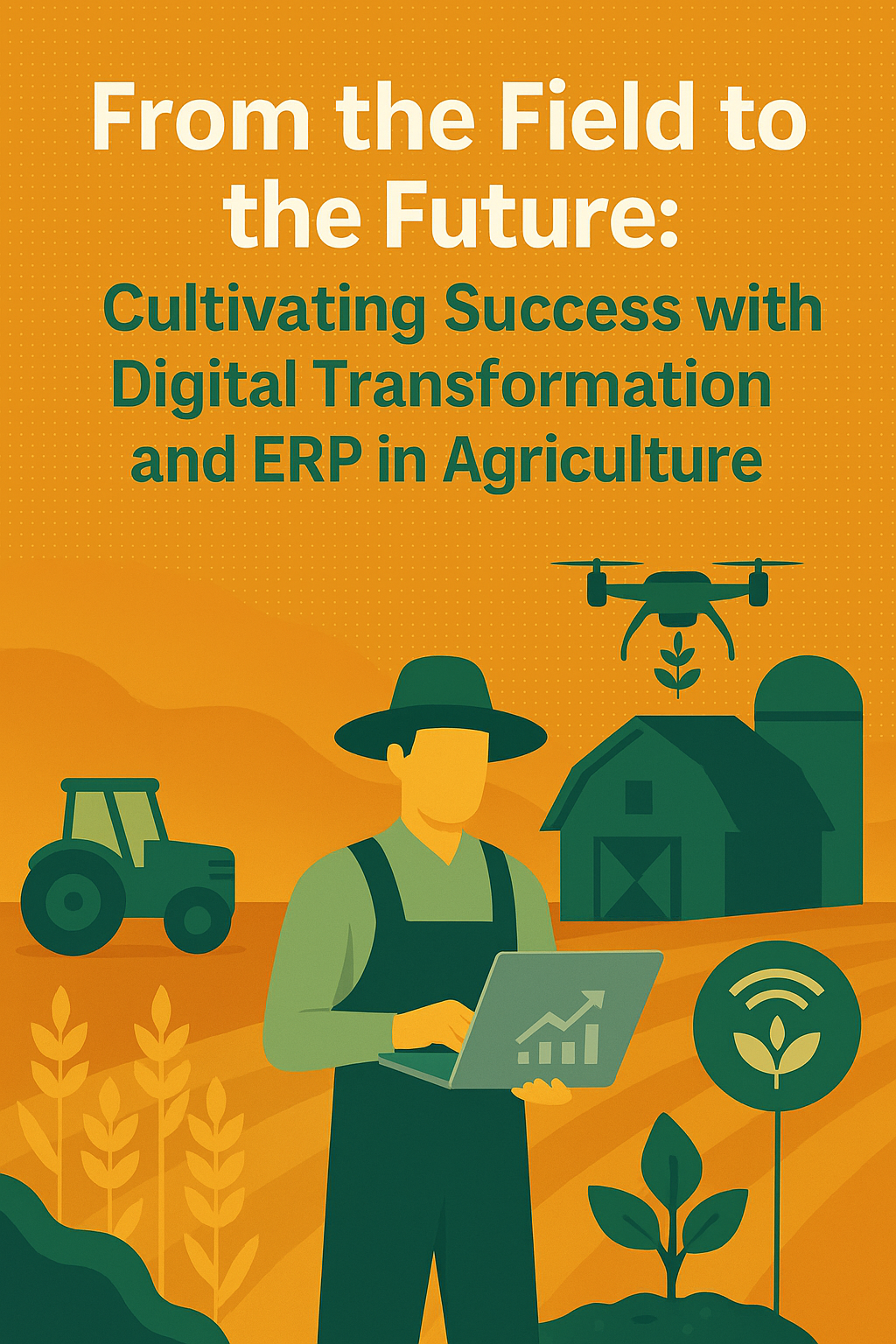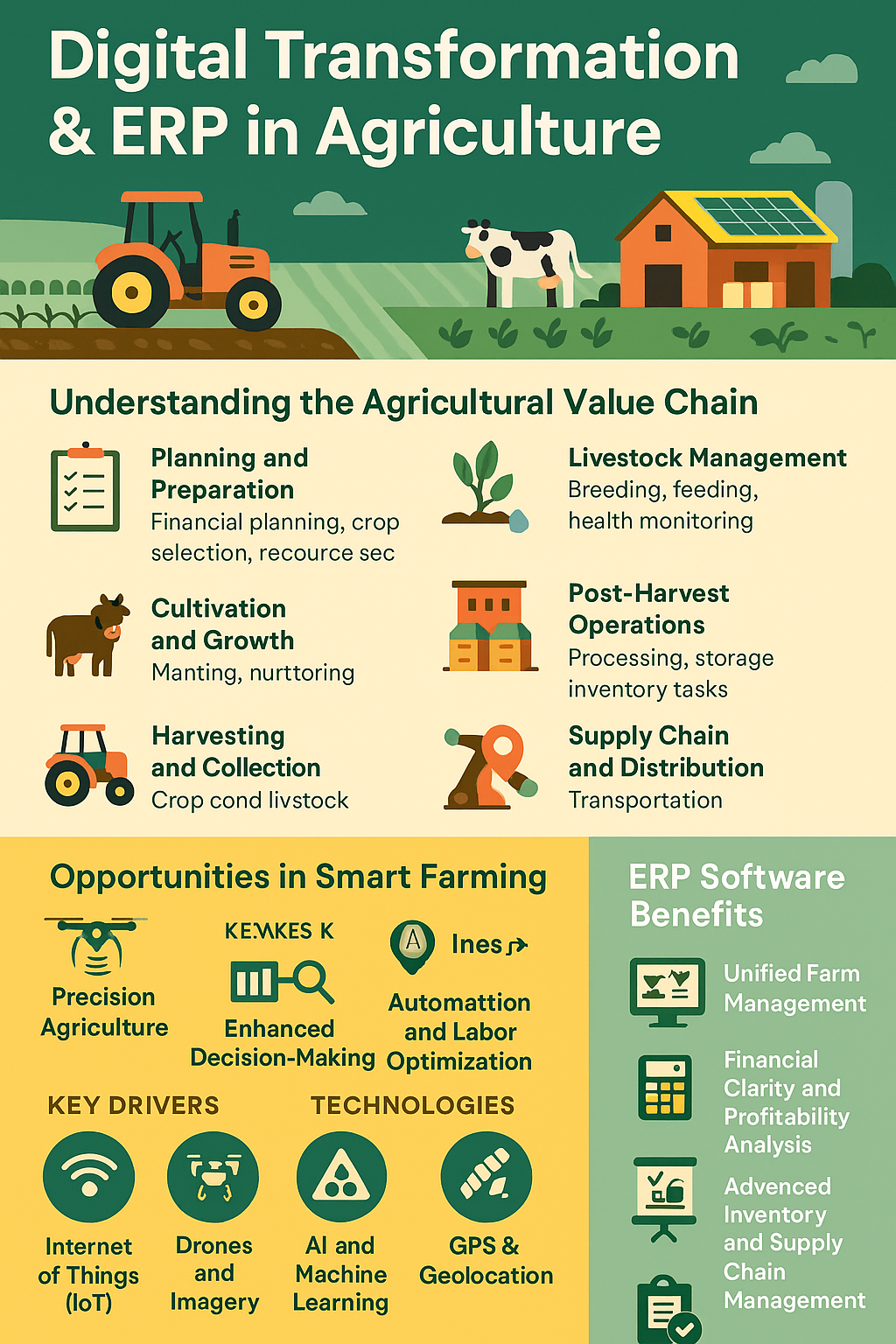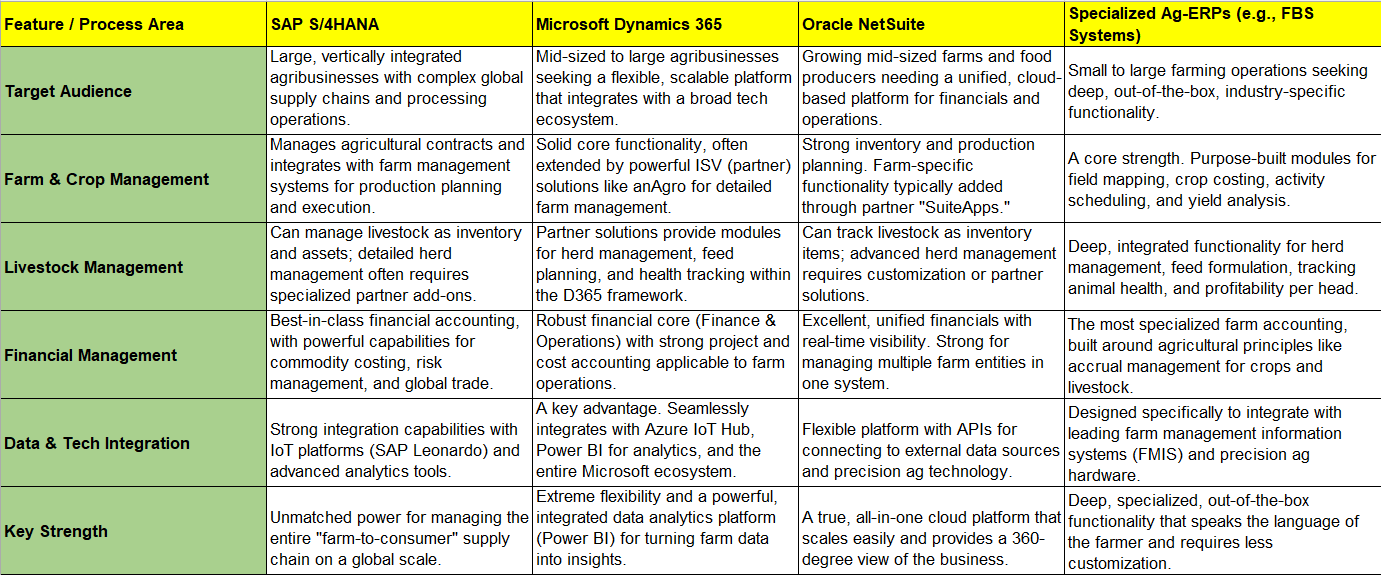From the Field to the Future: Cultivating Success with Digital Transformation and ERP in Agriculture
2025-07-10 · By Anil Kancharla · 7 min read
❤️ 0 Likes · 👁️ 0 Views
 AI-generated image for illustration purposes only.
AI-generated image for illustration purposes only.
From the Field to the Future: Cultivating Success with Digital Transformation and ERP in Agriculture
 AI-generated image for illustration purposes only.
AI-generated image for illustration purposes only.
The agriculture industry, humanity's oldest and most essential endeavor, is undergoing its most profound evolution yet. Standing at the dawn of "Agriculture 4.0," today's agribusinesses are no longer just farms; they are complex enterprises navigating immense challenges. From feeding a projected global population of 10 billion by 2050 to grappling with climate change, labor shortages, and volatile market prices, the pressure to produce more with less has never been greater.
In this high-stakes environment, the solution isn't just about working harder—it's about working smarter. Digital transformation is the new fertile ground for growth, offering unprecedented opportunities for efficiency, sustainability, and profitability. At the heart of this revolution lies a critical technology acting as the central nervous system for the modern farm: Enterprise Resource Planning (ERP) software.
This in-depth blog post will explore the intricate landscape of the modern agriculture industry, uncover the game-changing opportunities of digital transformation, and provide a comparative analysis of leading ERP solutions designed to help agribusinesses cultivate a successful future.
The Modern Harvest: Understanding the Agricultural Value Chain
To appreciate the impact of digital transformation, one must first understand the complexity of the modern agricultural value chain. It's a journey that extends far beyond planting and harvesting.
Planning and Preparation: The cycle begins long before a seed is sown. This involves financial planning, land analysis, crop selection based on market forecasts and soil health, and securing resources like seeds, fertilizers, and financing.
Cultivation and Growth (Crop Farming): This is the core production phase, involving: * Planting: Utilizing precision planters to ensure optimal seed depth and spacing. * Nurturing: Applying water, fertilizers, and pesticides with increasing precision to maximize growth while minimizing environmental impact. * Monitoring: Continuously tracking crop health, weather patterns, and soil conditions.
Livestock Management (Animal Farming): For livestock operations, this stage involves managing animal breeding, feeding schedules, health monitoring through veterinary care, and ensuring animal welfare standards are met.
Harvesting and Collection: This time-sensitive process involves using advanced machinery to collect crops at their peak. For livestock, it involves collecting products like milk or eggs or preparing animals for market.
Post-Harvest Operations: After collection, products undergo several steps: * Processing: Cleaning, sorting, grading, and sometimes initial processing (e.g., milling grains, pasteurizing milk). * Storage: Storing produce in controlled environments to maintain quality and freshness. * Inventory Management: Tracking stock levels, quality, and location.
Supply Chain and Distribution: The final leg involves transporting goods to processors, distributors, retailers, or directly to consumers. This requires complex logistics, traceability, and contract management.
The Digital Dawn: Opportunities Sprouting in the Agriculture Sector
The traditional image of farming is being rapidly replaced by one of high-tech, data-driven operations. Digital transformation, or "Smart Farming," is about applying modern information and communication technologies to every stage of the value chain.
Key Drivers and Opportunities:
- Precision Agriculture: This is the cornerstone of smart farming. By using GPS, sensors, and data analytics, farmers can move from managing entire fields to managing individual plants or small zones. This allows for the precise application of resources, leading to higher yields, reduced costs, and a smaller environmental footprint.
- Enhanced Decision-Making: Data is the new soil. Information gathered from drones, IoT sensors, and satellite imagery provides real-time insights into crop health, soil moisture, and pest infestations, allowing farmers to make proactive, data-backed decisions instead of relying solely on tradition and intuition.
- Improved Resource Management: Technology enables the efficient use of critical resources. Smart irrigation systems adjust watering based on real-time soil needs, and variable rate technology allows for targeted fertilizer application, conserving water and preventing nutrient runoff.
- Farm-to-Fork Traceability: Consumers and regulators are demanding greater transparency. Digital tools like blockchain and robust ERP systems can create an unchangeable record of a product's journey, from the seed it was grown from to the supermarket shelf, ensuring food safety and building consumer trust.
- Automation and Labor Optimization: With persistent labor shortages, automation is critical. Autonomous tractors, robotic harvesters, and automated feeding systems can perform tasks 24/7, increasing efficiency and freeing up human workers for more strategic roles.
The Tech Powering the Transformation:
- Internet of Things (IoT): A network of sensors placed in fields, on equipment, and on livestock to collect real-time data on everything from soil pH and moisture levels to an animal's body temperature and location.
- Drones and Satellite Imagery: Provide a bird's-eye view of the farm, helping to identify problem areas, monitor crop growth, and create detailed field maps.
- Artificial Intelligence (AI) and Machine Learning: AI algorithms can analyze data from various sources to predict yields, detect diseases early, recommend optimal planting times, and even identify individual weeds for targeted spraying.
- GPS and Geolocation: Essential for precision planting, automated steering of tractors (autosteer), and creating detailed yield maps during harvest.
The Central Silo: How ERP Software Unifies the Digital Farm
With a flood of data coming from sensors, drones, and machinery, how does a farmer make sense of it all? This is where an Enterprise Resource Planning (ERP) system becomes indispensable. An ERP designed for agriculture acts as the digital hub, integrating all this disparate data with the farm's core financial and operational processes.
Core Benefits of an Agriculture ERP:
- Unified Farm Management: Provides a single platform to view and manage all operations—from field mapping and crop planning to livestock herd management and equipment maintenance schedules.
- Financial Clarity and Profitability Analysis: Moves beyond basic accounting to offer deep insights. Track costs per field, per head of livestock, or per bushel. Analyze the profitability of different crops and make informed financial decisions.
- Advanced Inventory and Supply Chain Management: Manages everything from seed and fertilizer inventory to harvested crops in storage. Enables full farm-to-fork traceability, connecting lot numbers from the field directly to the end customer.
- Data Integration and Analytics: Connects directly with precision agriculture hardware and software, pulling in data from IoT sensors and machinery. It then translates this raw data into actionable insights and easy-to-read dashboards.
- Compliance and Sustainability Reporting: Simplifies the process of tracking and reporting data required for food safety regulations (like Global G.A.P.) and environmental standards. Monitor water usage, fertilizer application, and carbon footprint to support sustainability goals.
- Resource and Asset Management: Tracks the performance, maintenance schedules, and costs associated with expensive farm equipment. Manages land use contracts and leases efficiently.
Comparing the Crop: A Look at Leading ERP Solutions for Agriculture
Choosing the right ERP is a critical investment. Here’s a comparative look at how top ERP providers cater to the unique needs of modern agribusiness.

Cultivating Your Digital Strategy
The future of agriculture is digital, data-driven, and deeply interconnected. An ERP system is no longer a luxury for large corporations; it is a foundational tool for any modern agribusiness aiming for sustainable growth and profitability.
- For large, integrated enterprises that manage everything from seed genetics to supermarket shelves, SAP S/4HANA offers the horsepower to run a complex global operation.
- For forward-thinking agribusinesses that want to leverage data analytics and build a flexible, custom technology stack, Microsoft Dynamics 365 provides a powerful and adaptable foundation.
- For growing farms and food producers seeking a unified, scalable cloud solution to manage their entire business, Oracle NetSuite offers a compelling all-in-one package.
- For operations that prioritize deep, farm-centric functionality right out of the box, specialized ERPs like FBS Systems provide the focused tools needed to manage the unique financial and operational realities of farming.
By carefully selecting and implementing the right ERP, agribusiness leaders can break down data silos, gain unprecedented insight into their operations, and cultivate a business that is not only more profitable but also more resilient and sustainable for generations to come.
💌 Enjoyed this article?
If you found this post valuable, subscribe to my newsletter for more insights on digital transformation, AI, and business innovation.
👉 Subscribe to the newsletterOr let’s connect on LinkedIn — I share weekly content that’s practical for CIOs, CFOs, and transformation leaders.
🔗 Connect with me on LinkedIn